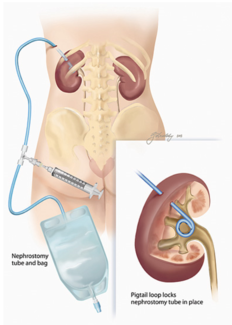Nephrostomy Insertion
Introduction
The urine from a normal kidney drains through a narrow muscular tube, called the ureter, into the bladder. It is dangerous for your kidney if this tube becomes blocked, especially if there is infection present. It is possible to relieve the blockage by inserting a fine plastic tube, called a catheter, through the skin into the kidney. This catheter then allows the urine to drain from the kidney into a collecting bag outside the body.
This procedure is called a percutaneous (meaning through the skin) nephrostomy (a tube put into the kidney) and is done under local anaesthetic.
Risks and benefits
This procedure will benefit you by reducing the toxins and fluid levels in your blood. It is a very safe procedure with a quick recovery and avoids the risks of surgery.
Occasionally we are unable to place a drainage tube in your kidney in which case you may need to have surgery to overcome the blockage. Also, sometimes urine might leak around the kidney and form a collection that requires draining.
It is common to have slight bleeding. Very rarely this may become severe and may require surgery to help you. There is a small risk of infection in the kidney or around it which can be treated with antibiotics.
We will discuss all of the risks and benefits with you in detail before your procedure.
Day of the procedure
Before the procedure
You must not have any food for 4 hours before your procedure and no drink for 2 hours before your procedure. You may need to have a blood test to check that your blood will clot properly. If you are not already in a gown your nurse will ask you to get changed into one, and then bring you to the X-ray department on your bed. In the X-ray department you will be seen by a doctor, who will discuss the procedure with you before you sign a consent form.
Please ask any questions you may have as it is important that you understand what is going to happen.
During the procedure
In the procedure room you will lie on your stomach on a special X-ray table. You may be given some strong pain relief, sedation and some antibiotics (if you are not on them already) through a needle in your arm.
Your lower back will be cleaned with antiseptic fluid and you will be covered with a sterile sheet. The doctor will give you an injection of local anaesthetic to numb the skin in your back which will cause some stinging initially and then go numb. Throughout the procedure a nurse will be with you who will monitor your pulse and blood pressure and might give you some oxygen.
The doctor will use an ultrasound guide and X-ray to decide on the most suitable point for inserting the catheter. They will then insert this catheter into your kidney over a fine wire. The catheter will be fixed to your skin surface and attached to a drainage bag. We will explain what is happening throughout the procedure. The procedure usually takes about an hour but may take longer.
After the procedure
You will go back to the ward where your nurse will record your pulse and blood pressure and check the urine in your catheter regularly. You will stay in bed for a couple of hours until you have recovered. If you feel unwell at any time, please tell your nurse.
How long will the catheter stay in?
Your specialist doctor looking after you can answer this question. The catheter may only need to stay in for a few days to allow a stone to pass naturally or it may need to stay in longer until the blockage is treated. Taking the catheter out should not be painful.
Your specialist doctor may wish for you to return to the X-ray department to have the catheter placed internally. This is called a ureteric stent. If this is the case, more information will be provided to you about this procedure.

Contact information
Chelsea and Westminster Hospital
Interventional Radiology Department
1st Floor, Lift Bank D
T: 020 3315 8570/8582

